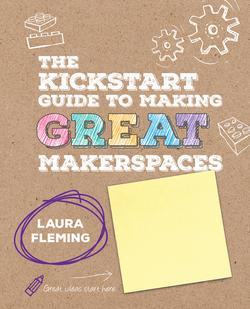Читать книгу The Kickstart Guide to Making GREAT Makerspaces - Laura Fleming - Страница 15
На сайте Литреса книга снята с продажи.
5 Differentiated
ОглавлениеProvide materials, activities, and supplies that meet the needs of all students. Create a learning environment that nurtures a community of learners.
All GREAT makerspaces are differentiated and effectively meet the needs of mixed-ability learners. Makerspaces can differentiate based on materials, content, learning environment, and process. A suite of multimodal materials is essential in meeting a wide variety of student learning needs and engagement styles. An easy way to differentiate access to content in your makerspace is to build in student choice. Centers or workstations in a makerspace can be used to encourage students to collaborate with their peers and can be a means of supporting differentiation. Consider the idea of alternative seating. In my makerspace, we have a combination of active seating for those students who need to move around, spaces to stand, high-top tables for students to sit or stand, and low stools and a countertop for those who prefer that setup. The unique learning environment of a makerspace invites students of varying abilities to work together. Creating a community of learners will make all students feel welcomed in your space.
A differentiated makerspace can allow students of all abilities to participate, experience success, and ultimately flourish. Students need to be supported as they develop increasingly sophisticated ideas over time. What this means for each student is different. In our makerspace, our students’ first interactions are often just about discovering. Gradually, through skill building, collaboration, and critical thinking, our students progress to much more complex processes related to engineering and scientific inquiry.
Many schools have begun using a specific process for making and creating in their makerspaces, such as design thinking, but it is important that the process is differentiated and eventually student-driven. Initially, process can be differentiated in many ways, including by providing varying levels of support for a task in a makerspace. As learners become more comfortable, we can gradually release the responsibility of a structured making process to complete learner independence. This type of flexible, self-directed learning will empower as well as enhance all learners’ unique learning abilities.
Photo courtesy of Medfield Public Schools, Massachusetts
To help students uncover and articulate the process they used to make and create, they can reflect on the various iterations involved in their making.
Ask them questions such as these:
What did you make/do?
What did you do first, second, and so on?
What materials did you use/work with?
What surprised you during the process?
What frustrations did you experience, and what did you do about them?
What steps did you use this time that you might want to use again?
What steps do you think you want to try next time you make something?
Students can also interview their peers or maker mentors to refine their own making process. The guiding question during these interviews should be: “Where do I see this maker doing something that I can do in my own making process?” You can support this by teaching students how to ask good questions, having students reflect on their own making, and finding a place in their own making where they can use what they learned from a maker mentor.
